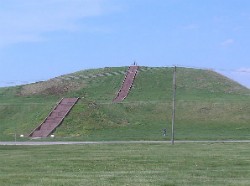Ten hours of sleep and a coffee addiction so dangerous it mirrors delirium tremens isn't always enough to keep Gut Check spry at work, so we're somewhat embarrassed to learn that prehistoric Cahokians built massive mounds with little more than a cup of black tea.
Yes, according to a new study by Patricia L. Crown, professor of anthropology at the University of New Mexico in Albuquerque, Native American dwellers of Cahokia sipped "a caffeinated tea-like beverage commonly known as 'black drink,' brewed from toasted holly leaves and stems."
The research fails to gauge how "black drink" compares to "purple drank," but we imagine if it mirrored it at all nary a mound would have been built -- though a different Birdman was involved.
What information researchers do know came from analyzing chemical residues absorbed into porous, unglazed mug-shaped ceramic cups excavated from Cahokia that date back to 1050-1250 AD, so says the study. Further, the scientists found traces of theobromine, caffeine and ursolic acid, which according to Crown's research:
"...constitute a chemical signature for the holly species, Ilex. Early European explorers reported that many Native Americans tribes of the southeastern United States historically used holly to prepare black drink, which was consumed during cleansing rituals and religious ceremonies."
Toasted holly (or its Latin name, Llex vomitoria) and its stems is believed to have been a popular drink among many Native American tribes of the Southeastern United States. Llex vomitoria species don't grow as far north as Cahokia, thus Crown believes that its inhabitants might have procured dried holly through trade. Crown and her colleagues speculate that the unglazed ceramic mugs might have been made specifically for black-drink ceremonies, which they suggest strengthens the hypothesis that Cahokia might have informed the social and religious traditions of other Native Americans in the Southeast region of the country.


